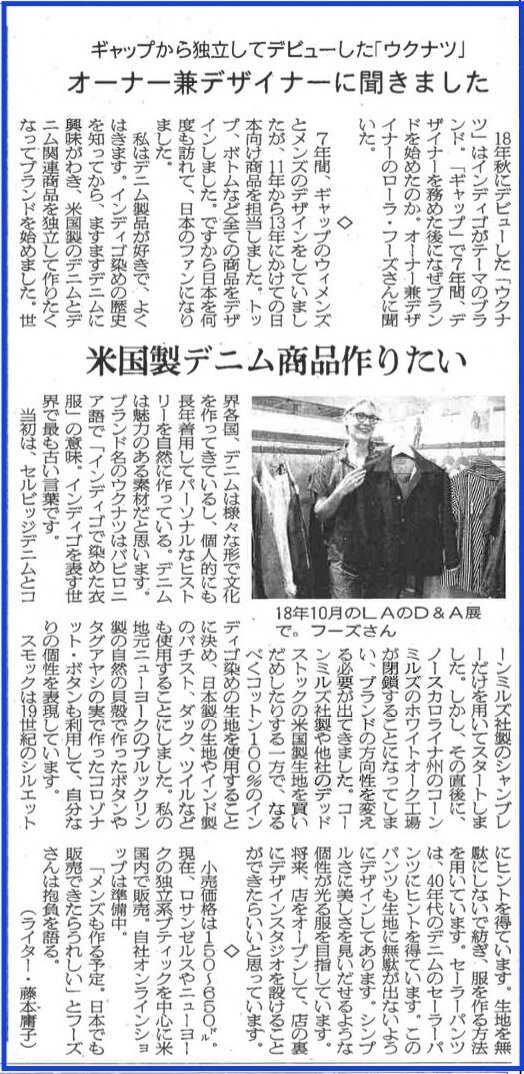Press


December 12, 2019 Senken-Shimbun
DESIGNER FORMERLY FROM THE GAP, DEBUTS UQNATU
By Yoko Fujimoto December 12, 2019
Excerpts from Interview with Uqnatu Owner and Designer Laura Foos
The name Uqnatu is the Babylonian word for indigo dyed cloth. It is the earliest written example of indigo in any language and was found on a cuneiform tablet from the 7th century BCE that is now in the British Museum.
I began Uqnatu with a few yards of selvage denim from Cone’s White Oak Mill. I wanted to have a line that was made in the USA of classic denim and chambray milled in North Carolina from cotton grown in America. Shortly after I started, Cone announced they were closing the White Oak Mill in Raleigh, NC. I was devastated but bought deadstock denim from White Oak and looked for other fabric sources. I found deadstock denim and stock fabrics from the USA and also Japan. I have added organic cotton fabrics from India. The concept of my line evolved quickly to encompass 100% cotton fabrics from global sources with a focus on denim and chambray. I have added some indigo dyed pieces and will continue to have indigo in the line.
I learned to sew as a child. My sister and I would sew clothes for ourselves during the summer break from school. I always loved fashion but decided to pursue Fine Arts instead. Years later, I studied pattern making to learn about construction and draping.
My main material is 100% cotton. Human beings have had a long history wearing woven and knitted cotton. On its own, it is a beautiful, honest fabric without synthetics added such as polyester or stretch. Cotton will break down naturally and not transform into toxic waste. I like to use natural shell buttons and corozo nut buttons which are actually made right here in Brooklyn.
I have always loved wearing denim and the natural way that it transforms over time and becomes a personal garment showing it’s history. I find the history of indigo dye fascinating. Indigo has been important for many cultures that each arrived at the method of extraction separately.
Even though denim is a niche market typically with the jeans and jackets, I also explore using it is unexpected ways. I have some iconic styles based on vintage pieces I have collected over the years. For instance, my denim smock is based on a 19th century silhouette. The pieces of the original are all rectangular. When people had spun the yarns and woven the cloth by hand they didn’t want to waste any of the fabric so the pieces were set right next to each other and shape was given through gathers, smocking and gussets. This basic type of garment exists in many different cultures for this reason. There is a beauty in this simplicity.
The first pant pattern I developed is from a 1940’s denim sailor pant that I love. It has a very high, narrow waist with a generous hip and thigh. It must have been tailored for a woman and the fit is a favorite with several of my friends. The side seams are cut on the straight grain which again makes the most use of the fabric consumption.
I also have a dervish dress and harem pant which are based on pieces I collected when I worked as a photographer on excavations in Turkey, Jordan, Syria and Egypt. I am curious about traditional clothing from other cultures and how they evolved from ancient concepts of clothing the body. There is an elegance and grace in them that stems from the practicality and comfort.
I plan to grow Uqnatu in a slow, thoughtful and organic way. I want to provide a focused collection that resonates with a growing number of individuals who care about the quality and thought that goes into the each garment they buy. To have a healthy business there needs to be consistent, honest, beautifully made product and to develop a relationship with the stores and ultimately with the customer. I want to add a men’s shirt and jacket to the collection as I have had requests from friends for that. I have always loved those items for myself and they have a constancy that does not change.
When you start something new you have to take one step at a time. I am doing most things myself so it is taking more time to get there! Eventually, I would like to have my own brick and mortar store someday with my studio in the back. It is important to be in stores so people can see, touch and try on the collection to get to know it.

April 24, 2020 Senken-Shimbun

October 22, 2018 Senken-Shimbun
